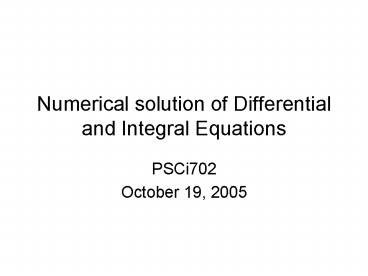Numerical solution of Differential and Integral Equations - PowerPoint PPT Presentation
1 / 32
Title:
Numerical solution of Differential and Integral Equations
Description:
Equations where the dependent variable appears as well as one or more of ... Certainly one can have homogeneous or inhomogeneous integral equations depending ... – PowerPoint PPT presentation
Number of Views:232
Avg rating:3.0/5.0
Title: Numerical solution of Differential and Integral Equations
1
Numerical solution of Differential and Integral
Equations
- PSCi702
- October 19, 2005
2
Differential Equations
- Equations where the dependent variable appears as
well as one or more of its derivatives. - The highest derivative present determines the
order of differential equation. - The highest power of the dependent variable or
its derivative sets the degree of the
differential equation.
3
Differential Equations
- Y-Y0 (1st order)
- Y(t)-Y(t)exp(t) (1st order)
- Y(t)-Y(t)t2 (1st order)
- YY-2Y0 (2nd order)
- YY-2Y0 (3rd order)
- YY20 ( 2nd degree, 1st order)
- Y(t)(Y(t)-Y(t))2 t ( 2nd degree, 2nd order)
4
Differential Equations
- Higher order equations can be reduced to a system
of first order equations.
5
Differential Equations
- When solving differential equations, the final
answer has a constant of integration in it. - If all the constants of integrations are
specified at the same place, they are then called
initial values and the solution is called initial
value problem. - If the initial values are not given at the same
place and are specified at different locations,
then the solution to the problem is called
boundary value problem.
6
Solution to Differential Equations
- Start the solution at the value of the
independent variable for which the solution is
equal to initial values. - Proceed step by step by changing the independent
variable and obtaining solution across the
required range. - Since most methods use local polynomial
approximation methods, stability becomes an issue.
7
One Step Methods
- Picards Method
8
Example
- Use Picard iteration to find the solution of
9
Example
10
Example
- The exact solution is
11
Runge-Kutta
- The method doesnt rely on polynomial
approximation. - Solution can be presented by a finite taylor
series of the form
12
Runge-kutta
13
Runge-Kutta
14
Error Estimate
- If solution is monotonically increasing, then the
error is increasing as well due to truncation. - In oscillatory solutions, the truncation error
introduces a phase shift. - The general accuracy can not be arbitrarily
increased by decreasing the step size. While it
will reduce the truncation error, it will
increase the effects of round-off error.
15
Error Estimation
16
Example
17
Example
18
Example
19
Predictor-Corrector Method
- By using the solution at n points, we can fit an
(n-1) degree polynomial. - The predictor part extrapolates the solution over
some finite range h based on the information at
prior points and inherently unstable. - The corrector part makes correction at the end of
the interval based on some prior information.
20
Predictor-Corrector Method
21
Predictor-Corrector Method
22
Predictor-Corrector Method
23
Systems of Differential Equations
24
Systems of Differential Equations
25
Systems of Differential Equations
- In vector form
- Where consists of elements which are
functions of dependent variables yi,n and xn. - A set of basis solutions is simply a set of
solutions, which are linearly independent. - Consider a set of m linear first order
differential equations where k values of the
dependent variables are specified at x0 and (m-k)
values corresponding to the remaining dependent
variables are specified at xn.
26
Systems of Differential Equations
- solve (m-k) initial value problems starting at x0
and specifying (m-k) independent, sets of missing
initial values so that the initial value problems
are uniquely determined. Let us denote the
missing set of initial values at x0 by
27
- The columns of are just the
individual vectors - Matix A will have to be diagonal to always
produce - So one can choose
- So the missing initial values will be
28
Systems of Differential Equations
29
Integral Equations
- Equations can be written where the dependent
variable appears under an integral as well as
alone. - Such equations are the analogue of the
differential equations and are called integral
equations. - It is often possible to turn a differential
equation into an integral equation which may make
the problem easier to numerically solve.
30
Integral Equations
31
Integral Equations
- The parameter K(x,t) appearing in the integrand
is known as the kernel of the integral equation. - Its form is crucial in determining the nature of
the solution. Certainly one can have homogeneous
or inhomogeneous integral equations depending on
whether or not F(x) is zero. Of the two classes,
the Fredholm are generally easier to solve.
32
Integral Equations































